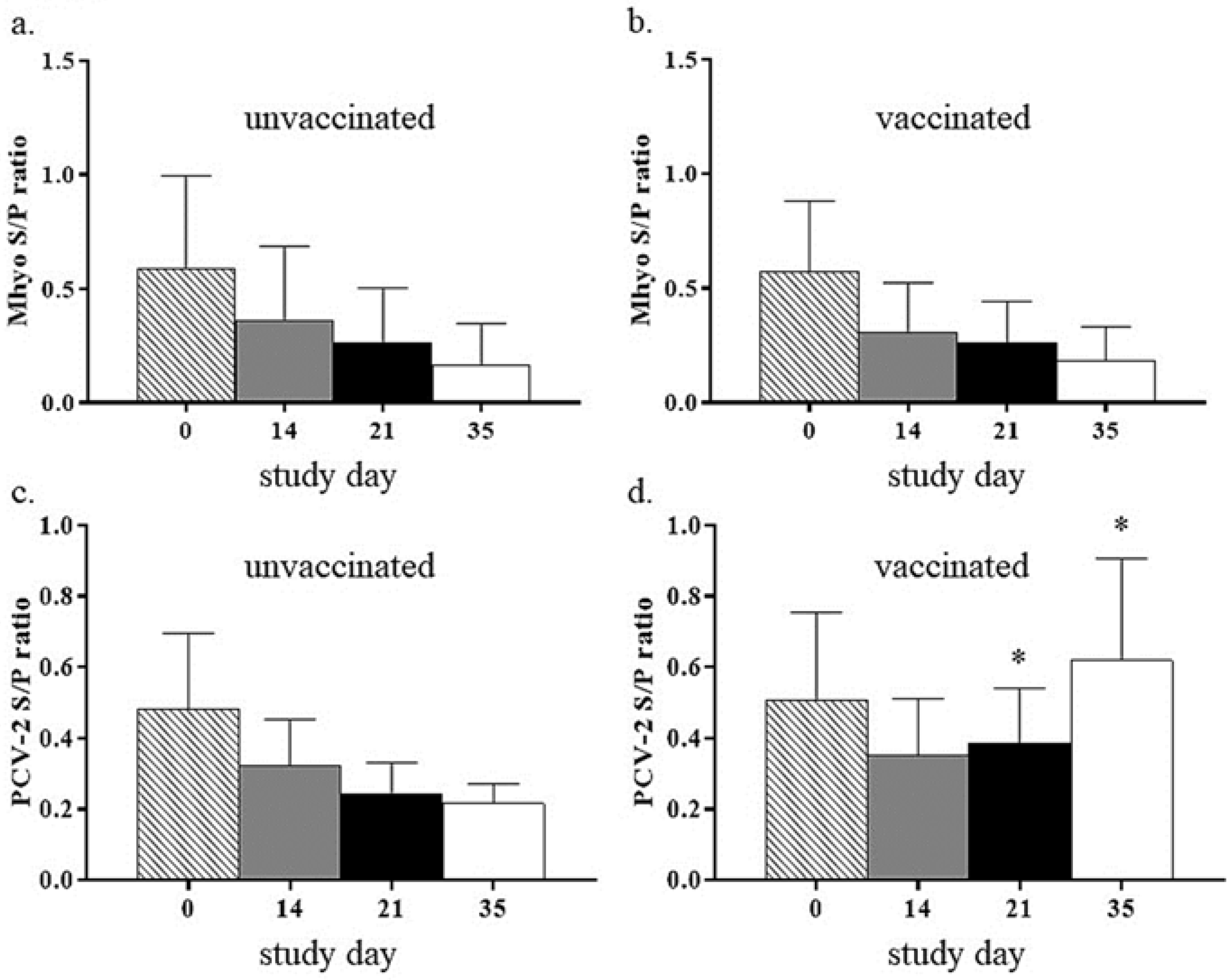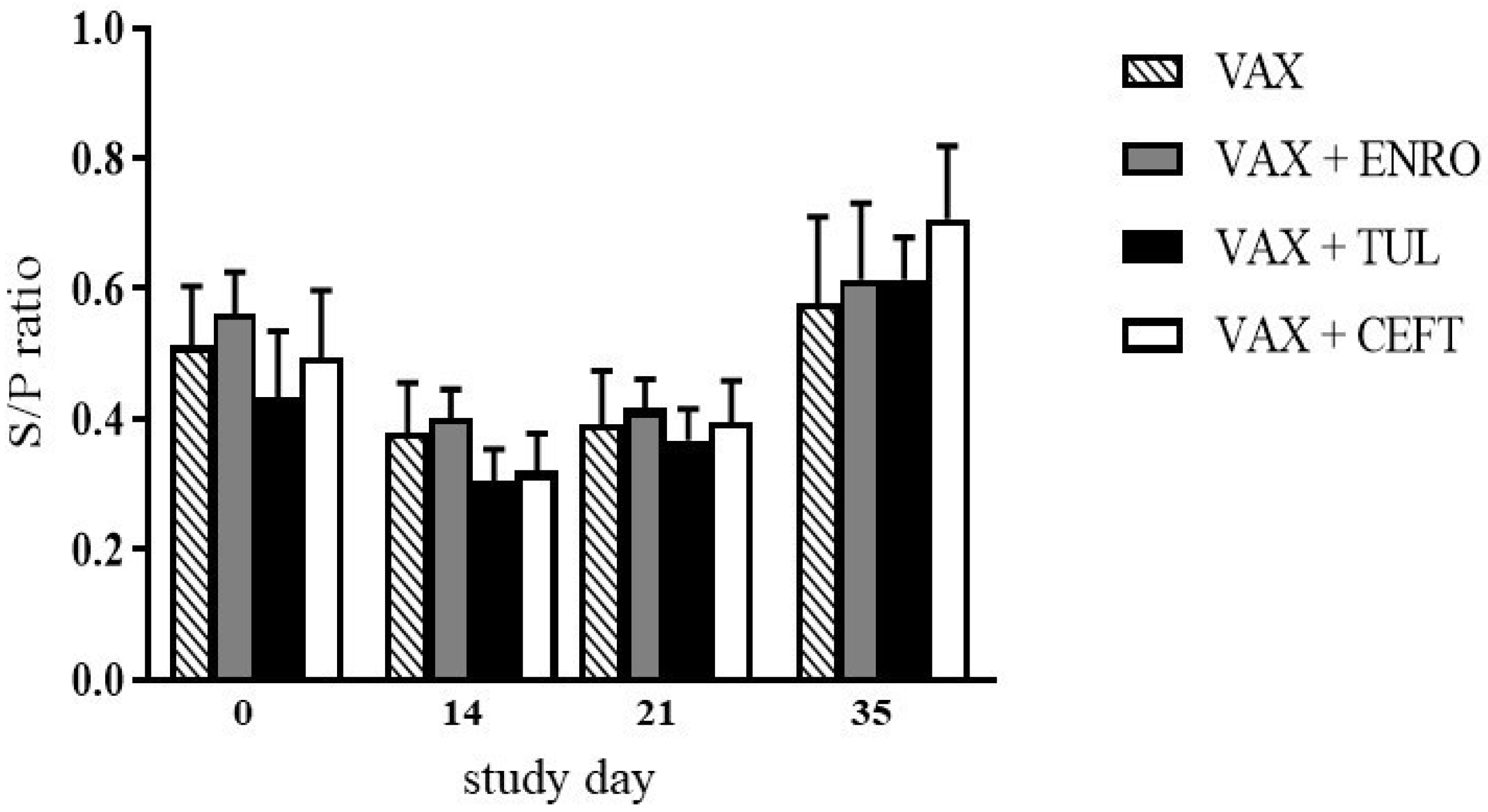Antibiotic Therapy Does Not Alter the Humoral Response to Vaccination for Porcine Circovirus 2 in Weaned Pigs
Abstract
1. Introduction
2. Materials and Methods
3. Results
4. Discussion
Author Contributions
Acknowledgments
Conflicts of Interest
References
- Pomorska-Mól, M.; Czyzewska-Dors, E.; Kwit, K.; Rachubik, J.; Lipowski, A.; Pejsak, Z. Immune response in pigs treated with therapeutic doses of enrofloxacin at the time of vaccination against Aujeszky’s disease. Res. Vet. Sci. 2015, 100, 68–74. [Google Scholar] [CrossRef] [PubMed]
- Pomorska-Mól, M.; Czyzewska-Dors, E.; Kwit, K.; Wierzchoslawski, K.; Pejsak, Z. Ceftiofur hydrochloride affects the humoral and cellular immune response in pigs after vaccination against swine influenza and pseudorabies. BMC Vet. Res. 2015. [Google Scholar] [CrossRef] [PubMed]
- Pomorska-Mól, M.; Kwit, K.; Markowska-Daniel, I.; Pejsak, Z. The effect of doxycycline treatment on the postvaccinal immune response in pigs. Toxicol. Appl. Pharmacol. 2014, 278, 31–38. [Google Scholar] [CrossRef] [PubMed]
- Pomorska-Mól, M.; Kwit, K.; Wierzchoslawski, K.; Dors, A.; Pejsak, Z. Effects of amoxicillin, ceftiofur, doxycycline, tiamulin and tulathromycin on pig humoral immune responses induced by erysipelas vaccination. Vet. Rec. 2016, 178. [Google Scholar] [CrossRef] [PubMed]
- Kick, A.; Tompkins, M.; Whisnant, S.; Flowers, W.; Almond, G.W. Effects of weaning age on the adaptive immune system in pigs. J. Anim. Sci. 2012, 90, 649–656. [Google Scholar] [CrossRef] [PubMed]
- Park, C.; Jeong, J.; Choi, K.; Chae, C. Efficacy of a new bivalent vaccine of porcine circovirus type 2 and Mycoplasma hyopneumoniae (FosteraTM PCV MH) under experimental conditions. Vaccine 2016, 34, 270–275. [Google Scholar] [CrossRef] [PubMed]


| Day 0 | Day 14 * | Day 21 * | Day 35 * | |
|---|---|---|---|---|
| CON | 4977 | 6887 | 8391 | 8628 |
| VAX | 4905 | 6951 | 8443 | 7837 |
| TUL | 4879 | 6272 | 7520 | 9147 |
| CEFT | 4646 | 6835 | 6975 | 10,074 |
| ENRO | 5176 | 5989 | 7105 | 8989 |
| VAX + TUL | 4495 | 6347 | 7389 | 8422 |
| VAX + CEFT | 4454 | 7041 | 7723 | 8141 |
| VAX + ENRO | 4351 | 6153 | 6098 | 7397 |
| Day 35 | % CD21+ | % CD3+ | % CD4+ | % CD8+ | % CD4+CD8+ |
|---|---|---|---|---|---|
| CON | 15.5 (1.6) | 44.0 (2.0) | 27.7 (2.0) | 12.4 (2.3) | 1.5 (0.6) |
| VAX | 15.9 (1.7) | 45.8 (2.5) | 25.3 (2.0) | 13.5 (2.4) | 0.3 (.07) |
| TUL | 15.2 (1.7) | 45.0 (2.7) | 22.5 (2.8) | 13.1 (1.7) | 1.7 (0.8) |
| CEFT | 13.2 (1.5) | 45.7 (3.5) | 23.6 (2.6) | 16.4 (3.1) | 0.1 (0.3) |
| ENRO | 12.6 (1.8) | 46.8 (2.9) | 20.0 (2.0) | 16.3 (2.4) | 0.8 (0.1) |
| VAX + TUL | 14.7 (2.0) | 47.2 (1.9) | 26.2 (2.0) | 13.1 (2.3) | 0.8 (0.2) |
| VAX + CEFT | 15.1 (1.8) | 46.4 (4.0) | 25.0 (2.1) | 16.9 (2.9) | 0.7 (0.2) |
| VAX + ENRO | 15.2 (1.6) | 42.3 (2.1) | 22.8 (3.6) | 14.9 (3.2) | 0.9 (0.3) |
© 2019 by the authors. Licensee MDPI, Basel, Switzerland. This article is an open access article distributed under the terms and conditions of the Creative Commons Attribution (CC BY) license (http://creativecommons.org/licenses/by/4.0/).
Share and Cite
Fogle, J.E.; Scott, J.A.; Almond, G.W. Antibiotic Therapy Does Not Alter the Humoral Response to Vaccination for Porcine Circovirus 2 in Weaned Pigs. Vet. Sci. 2019, 6, 51. https://doi.org/10.3390/vetsci6020051
Fogle JE, Scott JA, Almond GW. Antibiotic Therapy Does Not Alter the Humoral Response to Vaccination for Porcine Circovirus 2 in Weaned Pigs. Veterinary Sciences. 2019; 6(2):51. https://doi.org/10.3390/vetsci6020051
Chicago/Turabian StyleFogle, Jonathan E., Jenna A. Scott, and Glen W. Almond. 2019. "Antibiotic Therapy Does Not Alter the Humoral Response to Vaccination for Porcine Circovirus 2 in Weaned Pigs" Veterinary Sciences 6, no. 2: 51. https://doi.org/10.3390/vetsci6020051
APA StyleFogle, J. E., Scott, J. A., & Almond, G. W. (2019). Antibiotic Therapy Does Not Alter the Humoral Response to Vaccination for Porcine Circovirus 2 in Weaned Pigs. Veterinary Sciences, 6(2), 51. https://doi.org/10.3390/vetsci6020051





